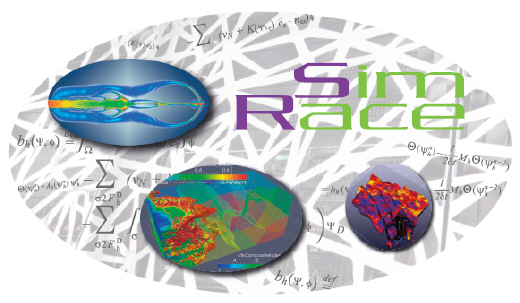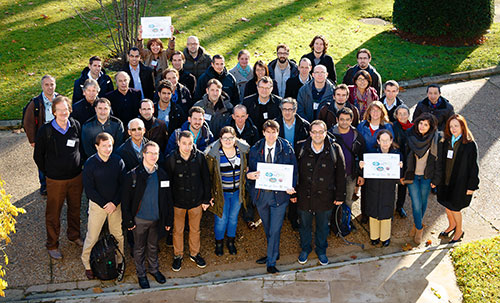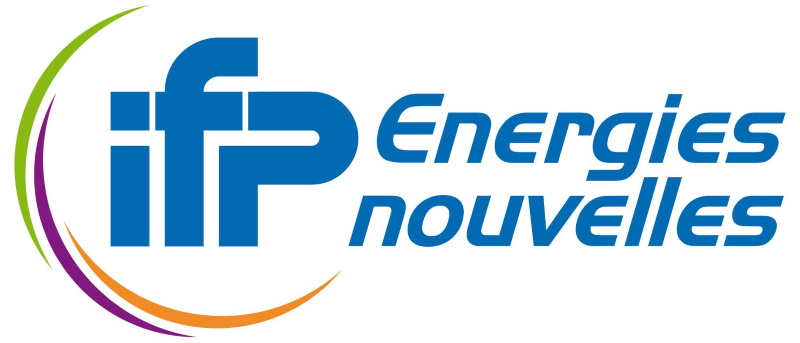Numerical Methods and High Performance
Computing for Industrial Fluid Flows - SimRace
IFPEN, Rueil-Malmaison, 8 - 10 December 2015 - 1st edition

IFP Energies nouvelles organized SimRace, the first conference in the Rencontres Scientifiques series entirely devoted to numerical methods and High Performance Computing (HPC) for industrial fluid flows.
For many applied fields dealing with complex fluid flows, like petroleum basins or reservoirs, automotive or aerospace engines, refining processes, etc., there is today an increasing need for ever faster and more accurate simulations.
SimRace offered the opportunity to mix HPC and numerical analysis in a synergistic way, bringing together scientists and engineers and providing a melting pot of ideas and views between researchers, developers and end-users.
SimRace was the place to be for exchanging knowledge at the forefront of progress in both fields,
with a special focus on:
- High-performance computational and programming models for emerging architectures
- Scalable linear solvers
- Numerical schemes on general meshes for complex flows
- Multi-scale methods and model coupling
- Challenging exaflopic applications
The SimRace International Conference was definitely be the right place for sharing on the challenge of designing new computational methods for exaflopic scale applications.

Special focus on
- High-performance computational and programming models for emerging architectures
- Scalable linear solvers
- Numerical schemes on general meshes for complex flows
- Multi-scale methods and model coupling
- Challenging exaflopic applications
Oral presentations:
- 45 minutes allotted for keynote speakers, including 5 minutes discussion
- 25 minutes oral presentations, including 5 minutes discussion
Poster session
Poster will be displayed during a dedicated session and throughout the conference. The posters should be set up during all the conference.
The useful size of the poster board is 90 cm wide x 150 cm height max. Velcro tape will be provided at the welcome desk of the conference.
Industrial session
The industrial sponsors of the conference will have the opportunity to present their products during a dedicated oral session followed by a time for discussions.
Official language
English will be the official language. Simultaneous interpretation will not be provided.
Conference proceedings
Abstracts from the oral and poster presentations will be included in a volume given out on site to all registered participants.
Download the conference highlights (PDF - 92Ko)
Tuesday 8 December
8.45 Registration
9.30 Opening of SimRace
S. de Chaisemartin, Scientific Correspondent of SimRace (IFPEN, France)
Welcome address
E. Heintzé, Scientific Director (IFPEN, France)
9.45 Challengers Presentation
Multi-level preconditioners for heteregeneous architecture
CanoP software for adaptive mesh refinement (AMR)
Feel++ finite element library embedded in C++
Presentation of Neptune CFD solver: architecture, schemes, HPC, applications
Session 1 – High-performance computational and programming models for emerging architecture
Chairperson: J-M Gratien, IFP Energies nouvelles, France
10.30 Keynote address by Barbara Chapman (Univ. of Houston,USA)
The challenge of portable parallel programming at Exascale
11.15 Automatic generation of adaptive simulation codes
C. Bastoul1, C. Sabater2 (1 Univ. of Strasbourg, INRIA, France ; 2 Univ. Nacional de Rosario, Argentina)
11.40 Break
12.10 Performance modeling of an industrial hydrocode on recent multicore processors
T. Gasc1,2,3, F. De Vuyst2, M. Peybernes4, R. Poncet5, R. Motte3 (1 Maison de la Simulation, 2 CMLA, ENS Cachan Univ. of Paris- Saclay, CNRS, 3 CEA, DAM, DIF, 4 CEA Saclay, DEN, 5 CGG, France)
12.35 Efficient solving strategies for incompressible Navier-Stokes equations for large scale simulations using the open source software Feel++
V. Chabannes1, C. Prud’homme2, M. Szopos2, R. TARABAY2 (1 Joseph Fourier Univ., 2 Institut de Recherche mathématique Avancée, Univ. of Strasbourg, France)
13.00 Lunch
14.30 Generation of adapted meshes on parallel architectures
A. Loseille (INRIA, France)
14.55 Solving strategy for large scale aerothermal simulation using the Open-Source Framework Feel++
Y. Hoarau, C. Prud’homme, J. B. Wahl (Institut de Recherche Mathématique Avancée, ICube, France)
Session 2 – Challenging exaflopic applications
Chairperson: M-C Sawley, Intel, France
15.20 Reactive particulate flows in rotating complex geometries
L. Bennani1,2, H. Neau1,2, P. Fede1,2, C. Baudry3, J. Lavieville3, O. Simonin1,2 (1 Toulouse Univ., 2 CNRS-Institut de Mécanique des Fluides de Toulouse,
3 EDF R&D, France)
15.45 Volume of fluid methodology for low pressure injection
W. Edelbauer1, D. Greif2, W. Schwarz2 (1 AVL List, Austria ; 2 AVL-AST d.o.o., Slovenia)
16.10 Break
16.40 High performance computation of particle-laden reactive fluidized flows in complex geometries at industrial scale
H. Neau1,2, C. Baudry3, P. Fede1,2, J. Lavieville3, O. Simonin1,2 (1 Toulouse Univ., INPT, UPS, IMFT, 2 CNRS-Institut de Mécanique des Fluides de Toulouse,
3 EDF R&D, France)
17.05 Industrial application of HPC for the resolution of complex flows in internal combustion engines
A. Robert, O. Colin, C. Angelberger, K. Truffin, J. Bohbot, N. Gillet, A. Velghe, S. Jay (IFPEN, France)
Wednesday 9 December
8.45 Registration
Session 3 – Multi-scale methods and model coupling - 1
Chairperson: B. Scheurer, CEA, France
9.30 Eulerian models for the description of polydisperse sprays: from fundamental issues to industrial applications and HPC
Keynote address by Marc Massot (École Centrale Paris, France)
10.15 Drag force for spherical and cylindrical particles at different packed bed porosities and wide range of Reynolds number
R. Brahem, A. Wachs, D. Ferré, A. Hammouti (IFPEN, France)
10.40 Projection-based FEVMS turbulence model with wall laws: application to industrial engineering incompressible fluid flows
S. Rubino (Univ. de Sevilla, Spain/LILL-UPMC, France)
11.05 Break
11.35 Direct numerical simulation of heat/mass transfer in gas-solid flows
F. Euzenat1,2, A. Wachs1, A. Hammouti1, E. Climent2, P. Fede2 (1 IFPEN, 2 IMFT, France)
12.00 Simulation of interfacial two-phase flows using P4EST, a cell-based AMR library
F. Drui1, 2, P. Kestener2, S. Kokh2,3, A. Larat1,4, M. Massot1,4 (1 EM2C, CNRS, École Centrale Paris, 2 Maison de la Simulation,
3 CEA/DEN/DANS/DM2S/STMF, CEA Saclay, 4 Fédération de Mathématiques de l’École Centrale Paris, CNRS, France)
12.25 Lunch
Session 3 – Multi-scale methods and model coupling - 2
Chairperson: R-O Fox, Iowa State University, USA
14.30 Massively parallel direct numerical simulation of three-dimensional water jet destabilization by a fast coaxial air stream
L. Kahouadji1, O. K. Matar1, J. Chergui2, D. Juric2, S. Shin3 (1 Imperial College London, UK ; 2 LIMSI-CNRS, France ; 3 Hongik Univ., Republic of Korea)
14.55 Comparison of numerical schemes for multiphase reactive transport
T. Faney, L. Rouvray, A. Michel (IFPEN, France)
15.20 A multiscale discontinuous Galerkin method for transport modeling
A. Konate1,2, V. Girault1, X. Claeys1, G. Enchery2, S. Desroziers2 (1 LJLL, UPMC, 2 IFPEN, France)
15.45 Break
16.15 Industrial session
Maison de la Simulation - Allinea - Hewlett Packard Enterprise - Intel - Synopsys
17.15 Posters session and exhibition
18.30 Bus transfer to the Domaine de Vert-Mont
19.00 Cocktail reception
21.30 Bus transfer from the Domaine de Vert-Mont to the hotels in Rueil and Nanterre, then to Place Charles de Gaulle Étoile in Paris
Thursday 10 December
8.15 Registration
Session 4 – Numerical schemes on general meshes for complex flows
Chairperson: B. Riviere, Rice University, USA
9.00 Keynote address by Lourenço Beirão da Veiga (Univ. of Milan, Italy)
The virtual element method: an introduction with focus on fluid flows
9.45 A virtual volume method for heterogeneous and anisotropic diffusion-reaction problems on general meshes
J. Coatléven (IFPEN, France)
10.10 Positive schemes for diffusion problems on deformed meshes
X. Blanc1, J-S Camier2, F. Hermeline2, E. Labourasse2 (1 LJLL, Paris Diderot Univ., 2 CEA, DAM, DIF, France)
10.35 Break
11.05 A large time step Lagrange-remap type method for the simulation of all-mach regime compressible flows
C. Chalons1, M. Girardin2, S. Kokh3 (1 LMV-UMR 8100, UVSQY, 2 CMAP-UMR 7641, École Polytechnique, 3 Maison de la Simulation, France)
11.30 Triangular metric-based mesh adaptation for compressible multi-material flows in semi-Lagrangian coordinates
S. Del Pino, I. Marmajou (CEA,DAM,DIF, France)
11.55 Lagrange-flux schemes: reformulating second-order accurate remapped Lagrange schemes for higher operational intensity and improved SIMD treatment
F. De Vuyst1, T. Gasc1,2,3, R. Motte3, M. Peybernes4, R. Poncet5 (1 CMLA, ENS Cachan Univ. Paris-Saclay, CNRS, 2 Maison de la Simulation, 3 CEA, DAM,
DIF, 4 CEA Saclay, DEN, 5 CGG, France)
12.20 Lunch
Session 5 - Scalable linear solvers
Chairperson: M. Kern, Maison de la Simulation/INRIA, France
14.00 Keynote address by Carol Woodward (Lawrence Livermore National Laboratory, USA)
A consideration of tradeoffs between nonlinear and linear solution methods in solving nonlinear models in the water cycle
14.45 S-step BiCGStab algorithms for geoscience dynamic simulations
A.Anciaux-Sedrakian1, L. Grigori2, S. Moufawad1, S. Yousef1 (1 IFPEN, 2 INRIA, France)
15.10 Adaptive and robust coarse space construction for domain decomposition methods
R. Haferssas, P. Jolivet, F. Nataf (UPMC, France)
15.35 Break
16.05 Using a posteriori error estimator and adaptative mesh refinement tools to enhance the performance of a thermal EOR compositional reservoir simulator
J. M. Gratien, O. Ricois, S. Yousef (IFPEN, France)
16.25 Analysis of IDR(s) solver for reservoir simulations on different parallel architectures
V. Seignole, J. F. Thebault, R. Nabil (Storengy-Engie Group, France)
16.50 Closing address

Congratulations to Ranine Tarabay and Jean-Baptiste Whal from IRMA-University of Strasbourg, winners of the SimRace Award sponsored by Hewlett Packard Enterprise for their work on the software Feel++
Tuned your own simulator to demonstrate how you could make efficient use of emerging architectures: multi-GPU, multi-cores, etc. Showed your software engineering skills guaranteeing the sustainability of your simulator within the fast-moving computer architecture world.
Highlighted the original numerical schemes that you used in your simulator. The innovative nature of the scheme focused on various objectives: precision of results, low computational cost with equivalent precision, ability to handle complex meshes, etc.
Ensured a fair comparison of competing simulators, and all the entries were assessed on 5 nodes of the IFPEN ENER110 supercomputer. These nodes contained 80 Intel SandyBridge cores and 10 NVidia K20m accelerators. The test phase on the cluster took place during November.
As long as your simulation worked on ENER110, we gave you the opportunity to present your simulator in a short five-minute talk at the beginning of the conference and highlighted its originality, along with its computing performance.
Showed your talents and tried to win the SimRace award!

